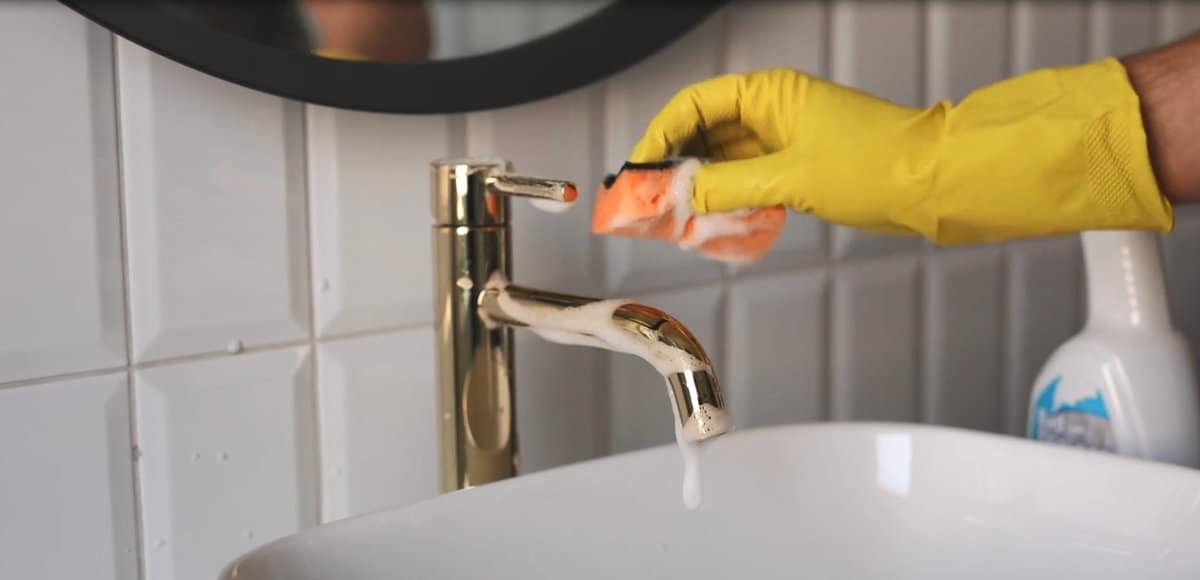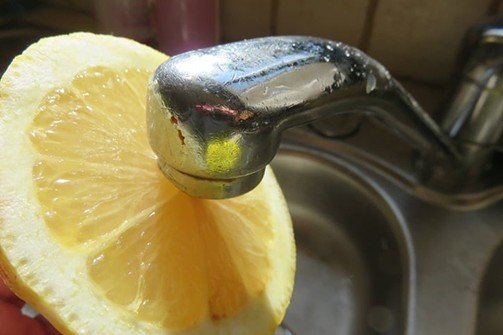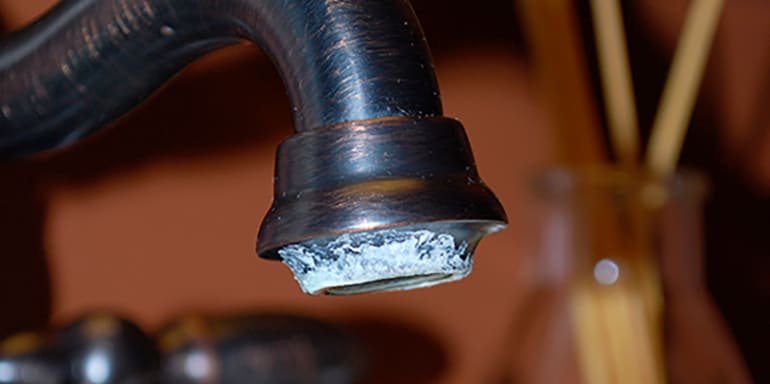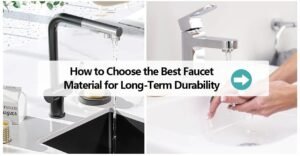Cleaning Bathroom Faucets
In contrast to common household items, bathrooms are subjected to much more than just regular filth, dust, and the occasional spill. Because of this, your bathtub, shower head, toilet, and/or faucet can amass germs, hard-water stains, mold or mildew, soap scum, and other unsanitary deposits over time. For this reason, it’s important to maintain a regular schedule of bathroom cleaning.

Aim to undertake a few basic cleaning activities once a week on average, while certain bathrooms may require more regular scrubbing with a soft cloth based on usage.
For instance, a joint kids’ bathroom will become grimy far more quickly than a guest-only powder room. Make your bathroom faucets gleam with our instructions on how to clean bathroom fixtures.
Cleaning The Bathroom Sink And Its Faucet

Calcium and hard water accumulation over time can clog shower heads and faucets, reducing water pressure and limiting optimum water flow. In severe circumstances, you might need to get out your tools and disassemble these plumbing components in order to get down and dirty and get rid of all the filth. But most of the time, using a few regular home materials, it is possible to clean faucets and shower heads without removing them.
Your faucet may become really dirty very quickly due to toothpaste, soap, hair, and general filth. It’s not difficult to clean your faucet properly, but it helps to have the necessary equipment and know the right practices.
You will need the following:
- Dry and wet cleaning cloths
- Dish-wash soap
- Warm water
- White vinegar solution
- Non-abrasive cleanser to remove hard water stains
- Old brushes to remove water spots
After you have all the necessary tools, follow the steps below:
Step 1: Thoroughly check your faucet
The majority of taps and faucets are constructed of durable chrome. These can withstand all of our cleaning techniques. However, be cautious when using more caustic chemicals if your faucet is not made of chrome. Lemon juice, vinegar, and baking soda are examples of ingredients with more severe pH values (i.e. acidic) that might damage the material of your faucet. When in doubt, first consult the manufacturer’s manual. Likewise, before moving on, always do a test on a tiny, discrete area of the faucet.
Step 2: Begin with Basic Cleansing (Dish soap and warm water)
You are now prepared to wipe down!
Fill one cup water and some dish soap in a bowl. Stir the mixture until it bubbles. Wipe off your faucets, taps, and hoses with a scrub or rag. But don’t forget to use soft, non-abrasive materials, such as microfiber, wherever possible. For optimal results, wait five to ten minutes. Next, use warm water to rinse the soap away. Finally, use a fresh, dry cloth for the surface.
On that note, do spare some time to thoroughly clean the faucet’s components. The top, knobs, and levers shouldn’t be overlooked. With an old toothbrush or soft cloth, softly scrub the faucet’s edges. And don’t forget to clean the faucet’s drain area as well. Oftentimes, a lever next to the tap may be used to control this drain region. And just for the record, you may also use vinegar-based glass cleaning solutions if dish soap is not readily accessible.
Step 3: Consider a more powerful cleaning method (Vinegar And baking soda powder)

- White distilled vinegar:Mix one cup vinegar with one cup water to make a cleaner solution and dab it on water stains or fingerprints on the faucet finish to remove them. Use a warm water+vinegar spray to give cleaning more of a boost.
- Remove calcium buildup by rinsing the faucet surface in one cup vinegar while it is covered with cling wrap or a plastic bag. Before removing and doing the aforementioned wipe down, with a soft cloth wait for five to ten minutes.
- Baking soda powder:Apply a little baking soda and a drop of water to the afflicted area to remove buildup and stubborn water stains. Before using a cleaning cloth again as described above, wait for five to ten minutes.
Step 4: Clean the Faucet's edges
Wiping the faucet’s surface with a soft cloth is a nice place to start, but it won’t do the trick alone. The edges of most faucets tend to have dirt buildup where the sink and the faucet connect. With an old toothbrush as your cleaner, tidy the edges with dish soap or just water. And don’t forget to wipe the faucet with a cleaning cloth.
Step 5: clean the drain area of the bathroom sink
Generally, the faucet’s drain section requires the most maintenance. To clean the bathroom sink, try using a nonabrasive cleaner. Moreover, when checking for surface damage, it’s a good idea to try any cleaning on a hidden area of the faucet.
How to Use A Lemon To Clean Faucets
If you want something more “natural” or don’t have any vinegar on hand, try this:
- Slice a lemon in half.
- Use your thumbs to carefully pry apart the middle of one of the sides.
- Squeeze the lemon onto the end of the bathroom faucet.

- Put a rubber band over the faucet and place a tiny plastic bag around the lemon. Make sure the lemon is covering the faucet’s end and the rubber band is fastened securely.
- To let the citric acid do its job, leave the lemon undisturbed for a few hours.
- After discarding the lemon, use a soft cloth or cleaning pad to remove any residual hard water buildup. Your faucet will be spotless once you use a damp cloth to wipe away any remaining lemon juice.
Calcium Buildup Removal From The Faucet

First and foremost, you need to wear rubber gloves. Thanks to this, your skin will be shielded from the irritants in many calcium buildup removers. Before you begin cleaning, make sure they are clear of filth. In case the cleaner spray spills, use gloves that extend all the way to or most of your forearm. But if you are using vinegar, you may omit this step.
Step 1: Use water to dilute the calcium remover
- In a bowl or previous plastic container, combine one part calcium remover with one part water. Pick a container that will go in the recycle bin. Most taps only require 1 to 2 teaspoons (15 to 30 mL) of each component.
- Use pure white vinegar in replacement of CLR and water if there isn’t much calcium buildup. Although it will take significantly longer—about 24 hours—this procedure is suitable for most faucet finishes and nontoxic to exposed skin.
- On faucets made of iron or nickel, avoid using vinegar or calcium remover. That’s because these cleansers will take off the finish along with the grime you’re cleaning.
- Consult your owner’s manual or ask a nearby plumber for assistance.
Step 2: Put the mixture in a baggie made of plastic
Use a sandwich bag that is standard size. The zip closure on the baggie is irrelevant. Pour with caution. Also, if you’re worried about spilling it, use a funnel to pour the mixture into the baggie.
Step 3: Attach the baggie to the faucet
Holding the baggie at a slight angle will allow the mixture to accumulate in one corner. Slide the baggie’s open end slowly over the faucet. Then pour the mixture into the tap. Use a rubber band to safely attach the baggie to the faucet. After that, let the faucet soak for one to two hours.
Step 4: Remove the baggie
Take the rubber band off. Slide the baggie off the faucet slowly. Proceed gently. Check the cleaner’s packaging for disposal directions before using. Cleaners like CLR may be flushed down the toilet or drain and are biodegradable.
Step 5: Rub away the loosened deposits
Use a magic eraser or an old toothbrush. Gently move the scrubber back and forth. If the toothbrush or magic eraser becomes too grimy, rinse it occasionally. Do this repeatedly until all of the accumulation has been cleared.
Step 6: Dry the faucet with a cloth
Gently move the cloth in a circular or back-and-forth motion. Keep a close eye on the tap to prevent further calcium accumulation. Keep going till the faucet is completely dry.

Some Optional Recommendations
- Several businesses provide lifetime warranties on newly installed faucets. Using caustic drain cleaners or other corrosive substances on the faucets may void these warranties. Knowing if you have a warranty is a good idea. If you do, avoid using cleaning products or drain cleansers that can invalidate the insurance.
- A living finish is a unique type of texture that some faucets feature. The patina and ageing of this faucet are intended effects. Any cleaner other than water will remove some or all of the patina off the faucet. Carefully avoid chipping the patina if you like it.
- For the majority of finishes, scrub sponges and abrasive brushes are not recommended.
- Use dental floss to tidy up little cracks. A 12-inch (30.48-cm) length of floss should be cut off. Put the string in the gaps or crevices in the faucet’s surface. Similar to how you would while flossing your teeth, move upward and downward.
- An additional ideal alternative for cleaning your faucet is a mild glass and surface cleaner.
- Try dabbing a little baby oil on a cotton ball to make your chrome faucets shimmer and sparkle. Clean the faucet with the baby oil. As a result, you’ll even be able to clearly see your own reflection.
Final Thoughts
When it comes to home improvement, there’s a lot that needs cleaning in the bathroom. However, it isn’t just the toilet, bathtub or the shower curtain that needs your attention, but also other bathroom fixtures such as the faucet. As you can see from above, there are many different ways to rinse the grime and remove hard water stains from your faucet’s finish.
But before you scrub and wash the water spots and stubborn stains, make sure you have all the necessary cleaning equipment. And last but not least, do have a look at the manufacturer’s instructions so you don’t end up using the wrong cleaner while trying to remove water spots and soap scum. Likewise, when buying your bathroom faucet, always trust a reliable and trustworthy manufacturer such as Faucetu Manufacturer’ in China, who can provide you products as per your customization needs.




